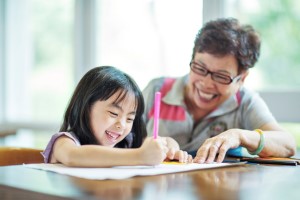Emotion Coregulation in Mother Child Dyads
A Dynamic Systems Analysis of Children with and without Autism Spectrum Disorder - a study from Yuqing Guo & Dana Rose Garfin & Agnes Ly & Wendy A. Goldberg, published in the Journal of Abnormal Child Psychology.

Abstract
Few studies have investigated patterns of emotion coregulation in families of children with Autism Spectrum Disorder (ASD) or contrasted the ways in which their emotion coregulation patterns differ from families of typically developing (TD) children.
To address this gap, we used a dynamic systems approach to compare flexible structure and emotional content of coregulation between mothers and children (3–7 years) with ASD (n = 47) and TD children (n = 26). Mother-child play interactions in the home were videotaped and emotion-engagement states were coded in micro-level 5-s intervals based on behavioral and affective expressions.
Analyses indicated that mother-child dyads in the ASD group spent more time than dyads in the TD group in mismatched emotion-engagement states (e.g., child negative/mother positive), and children with ASD spent more time than TD children engaged exclusively with objects. Mother-child dyads in the TD group stayed longer in mutual positive engagement states. Compared to dyads in the TD group, mother-child dyads in the ASD group exhibited greater flexibility (i.e., a wider range of emotional-engagement states, more frequent changes in states, and less time in each state). These findings suggest that mothers and their children with ASD do not sustain dyadic positive engagement patterns in a low-stress environment.
Findings confirmed the preference of children with ASD for objects over social partners, even when they are at home with their mothers, and elucidated a challenging other-child interactional style. Results have implications for mother-child interventions aimed at regulating negative emotional states and sustaining positive ones in families raising children with ASD.
Early theorists posited that our understanding of typical and atypical child development relies on analyses of the emotion regulation process (Cole et al. 1994). Emotion regulation (i.e., how individuals manage their emotional experiences and expressions) involves automatic and intentional modifications of emotional states (and by extension behavioral responses) to promote adaptive or goal-directed behavior; these transitions between states are commonly referred to as flexibility (Thompson 1994). Negative emotional states tend to decrease attentional control and constrict behavioral responses, whereas positive emotions tend to increase attentional control and expand behavioral responses to environmental demands (Fredrickson et al. 2000). Thus, increased flexibility is generally considered an adaptive characteristic. Specific to early childhood development, internal and external regulation, including flexibility, are critical as the child shifts from depending on caregivers for emotion regulation (i.e., external regulation) to self-regulatory (i.e., internal regulation) processes (Tronick 1989).
For the coding of the videos the researchers used Mangold INTERACT.
